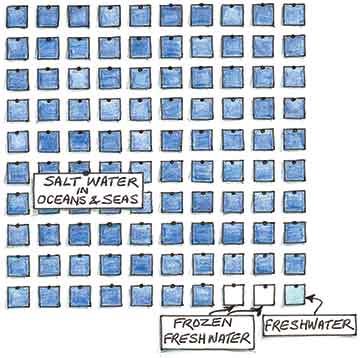Kobita Dass Kolli
This is a cross curricular approach which includes simple activities to help primary school children understand how much water there is on earth and how much of it is available to us, as well as how the water cycle works and how we use water. This will form the basis to develop the concept of limited water availability, its uses, and its conservation.
So much water
A good way to begin would be to put up a physical map of the world or set up a globe. Point out the major water bodies. Does the earth have more land or more water? Spot the oceans, seas, major lakes and rivers. Explain that the oceans cover three quarters of the earth’s surface and are very deep. That’s a lot of water!
 There is a lot of water on earth, but how much of it is available to us? Compare the size of the salty oceans with that of the freshwater rivers, lakes and areas covered with snow and ice (the polar regions). Ninety-seven per cent of the water on earth is salty and only 3% of it is freshwater. The oceans and seas are home to several animals and plants that can live in salt water, but humans, and landplants, and animals require fresh water! Of the 3% that is fresh water, 2% is frozen in glaciers and ice-caps, therefore only 1% of total water on earth is available to us. Here is a simple activity that will illustrate this limited supply of water. Cut out one hundred 2×2 inch squares of paper. Have the children colour 97 of them dark blue to represent water in the oceans and seas (salt water). Leave 2 squares white to represent the water held in the frozen glaciers and ice-caps. One square will be coloured pale blue to indicate fresh water in lakes, rivers and underground sources. Pin these up on the soft-board in a 10×10 grid. This will give the children a visual to better understand, that despite the large amount of water on earth (100 parts) only a small amount (1 part) is available to us.
There is a lot of water on earth, but how much of it is available to us? Compare the size of the salty oceans with that of the freshwater rivers, lakes and areas covered with snow and ice (the polar regions). Ninety-seven per cent of the water on earth is salty and only 3% of it is freshwater. The oceans and seas are home to several animals and plants that can live in salt water, but humans, and landplants, and animals require fresh water! Of the 3% that is fresh water, 2% is frozen in glaciers and ice-caps, therefore only 1% of total water on earth is available to us. Here is a simple activity that will illustrate this limited supply of water. Cut out one hundred 2×2 inch squares of paper. Have the children colour 97 of them dark blue to represent water in the oceans and seas (salt water). Leave 2 squares white to represent the water held in the frozen glaciers and ice-caps. One square will be coloured pale blue to indicate fresh water in lakes, rivers and underground sources. Pin these up on the soft-board in a 10×10 grid. This will give the children a visual to better understand, that despite the large amount of water on earth (100 parts) only a small amount (1 part) is available to us.
The water cycle
Begin this lesson with an experiment to show evaporation and condensation. Take a wide, transparent bowl, fill with water until three quarters full, place it in a large plastic bag and seal or tie the open end to make it air tight. Make sure that the bag is puffed up so that the interior is a clear space. It’s a good idea to mark a few lines on the side of the bowl to clearly see the changes in the water level. Place the bag in a sunny place for 3-4 days.
The author is a Hyderabad based illustrator and identity designer and holds an M.Phil in Plant Sciences. She is also a nature enthusiast and enjoys working with fourth graders on nature awareness and gardening at Vidyaranya School. She can be reached at kobi25dk@gmail.com.
